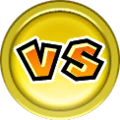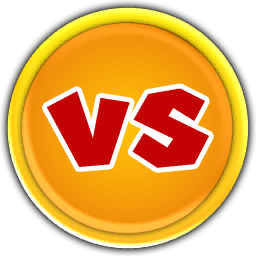Minigame Space
Template:Space-infobox The Minigame Space (also formatted as Mini-game Spaces) is a special space found in Mario Party. If a player lands on this space, the player plays a single-player minigame to earn coins for only the player. If the player loses, the player loses 5 Coins, with the exception of some minigames.
In Mario Party 3's Duel Mode boards, it appears again, this time with Tumble's face depicted on it. In this game, landing on it begins a Duel minigame hosted by Tumble. The winner of the minigame receives 10 Coins from Belltop.
In Mario Party 5, they only appear in Story Mode and are known as VS Spaces. When landed on, a VS Minigame hosted by Misstar begins, in which the winners take Coins from the losers. The type of minigame played and the number of Coins at stake depends on the number of Koopa Kids remaining: when all three remain, 15 Coins are at stake and a 1-vs.-3 minigame is played; when two remain, 20 Coins are at stake and a 2-vs.-2 minigame is played (with Toad as the player's ally); when only one remains, 20 Coins are at stake and a Duel minigame is played. If the player wins, the Coins taken are split up among the Koopa Kids (5 Coins each when all three remain, for example), and Misstar awards the player their Coins. If the Koopa Kids win, the player must give up the full number of Coins themselves and the winnings are split up among the Koopa Kids by Bowser, who flattens the player similar to his appearance on a Bowser Space.
In Mario Party Advance, Minigame Spaces function as they did previously, except for the fact that they reward Mushrooms, which constitute the player's turns. Two characters can appear to challenge the player: Tumble, who gives the player two Mushrooms for completing a minigame, or Koopa Kid, who gives the player one Mushroom for succeeding and steals a Mushroom if the minigame is failed.
Later, it makes an appearance in the Mario Party 6 Solo Mode. When a player lands on this space, they play either a 4-Player minigame, a 1-vs.-3 minigame or a 2-vs.-2 minigame, againts the three different colored Koopa Kids. There is also a space called the Battle Minigame Space, and a Duel Minigame Space. The Duel Minigame Space makes the player challenge a Koopa Kid in a one-on-one battle.
The space returns in Mario Party: Island Tour. In the board Perilous Palace Path, the three winners of this initial minigame will get to choose between three random items. In Rocket Road, the initial winner gets the boosters of the player who landed on the space. If a tie occurs in a minigame for any position, a Dice Block decides.
Minigame Spaces reappear in Mario Party 10. When players land on it, they need to punch a block to decide what type of minigame they play. Here are the types of minigames players can play and the payouts:
- Free-for-All (vs. 2, 3, or 4)
| Position | 2 Players | 3 Players | 4 Players |
|---|---|---|---|
| 1st | 5 Mini Stars | 5 Mini Stars | 5 Mini Stars |
| 2nd | 1 Mini Star | 3 Mini Stars | 3 Mini Stars |
| 3rd | - | 1 Mini Star | 2 Mini Stars |
| 4th | - | - | 1 Mini Star |
- 1 vs. 3 or 1 vs. 2 (3 or 4 players only)
- The Captain is the solo player.
| Result | 1 vs. 2 | 1 vs. 3 |
|---|---|---|
| Captain Wins | 5 Mini Stars | 7 Mini Stars |
| Other Team Wins | 3 Mini Stars | 3 Mini Stars |
| Draw | 4 Mini Stars | 4 Mini Stars |
- 2 vs. 2 (4 players only)
- 1st place and 4th place team together while 2nd place teams up with 3rd place.
- The winners each get 10 Mini Stars. If a draw occurs then each player earns 5 Mini Stars.
- Battle
- Hammer Bro. comes out and forces all players to bet 5 Mini Stars for the next Minigame. If Mini Stars are insufficient then Hammer Bro. makes up the difference.
| Position | 2 Players | 3 Players | 4 Players |
|---|---|---|---|
| 1st | 10 Mini Stars | 10 Mini Stars | 10 Mini Stars |
| 2nd | 0 Mini Stars | 5 Mini Stars | 6 Mini Stars |
| 3rd | - | 0 Mini Stars | 4 Mini Stars |
| 4th | - | - | 0 Mini Stars |
Names in other languages
| Language | Name | Meaning |
|---|




